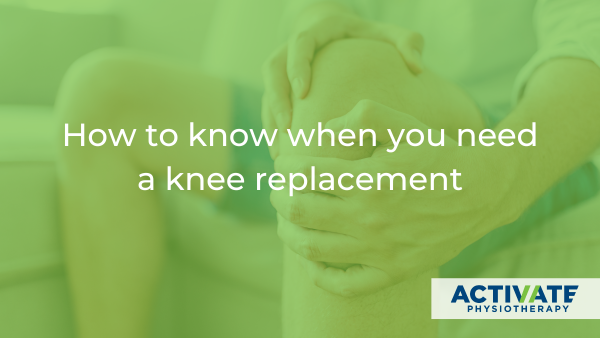Let’s delve deeper into a question we often hear from our patients at Activate Physiotherapy: “How do I know when it’s time to get a knee replacement?” This is an important query, especially for those dealing with the discomfort of knee osteoarthritis. So, grab a comfy chair and prepare to embark on an informative journey about knee health.
Let’s begin with a fundamental understanding of osteoarthritis, a condition that affects the joints, with the knee joint being one of the most frequently targeted areas. Osteoarthritis brings pain, stiffness, and reduced mobility to the knee, which can significantly impact your daily life. But before we jump straight to the conclusion you need surgery; It’s important to know there are several non-surgical options that can effectively manage knee osteoarthritis.
What is the best treatment for knee osteoarthritis?
At Activate Physiotherapy, we firmly believe in starting with conservative approaches. In fact, the research shows these are THE MOST effective ways to manage osteoarthritis of the knee (and the hip too!). If you’re grappling with knee osteoarthritis, here’s a comprehensive plan to help you manage the condition effectively:
Exercise:
Regular, well-designed exercises can work wonders for your knee joint. Strengthening the muscles around the knee can help stabilize it, reduce pain, and improve overall function. It’s like giving your knee a friendly support system.
Weight Management:
Maintaining a healthy weight is crucial. Extra pounds put additional stress on your knee joints. By shedding those extra kilos, you’ll be doing your knees a massive favor. Think of it as lightening the load on a worn-out bridge.

Education:
Knowledge is power. Learning about your condition and understanding how to manage it can make a significant difference. Our team at Activate Physiotherapy can provide you with insights and guidance, making you feel more in control of your knee health.
How do I know when I need a Knee Replacement?
Now, let’s delve deeper into the million-dollar question: when should you consider a knee replacement? Our team are firm believers it’s not a decision to take lightly. Joint replacement surgery is not a magic cure is typically the last resort when conservative treatments have been tried, and the pain and disability have become too much to bear. Surgery comes with risks and of course a cost both financially and in the time it will take to recover.
But that being said, if you’ve given conservative management a red-hot crack here are a few signs that might indicate it’s time for a knee replacement:
Persistent Pain:
When your knee pain is relentless and hinders your daily activities, even after trying various non-surgical treatments, it may be time to discuss surgery. This continuous pain can significantly affect your overall well-being and quality of life.
Loss of Function:
If your knee’s limitations have taken away your ability to do the things you love, like walking, climbing stairs, or enjoying your favourite hobbies, it’s a signal that a knee replacement might be necessary. A knee that isn’t functioning properly can hold you back in many ways, both physically and emotionally.
Joint Damage:
Severe damage to the knee joint, often visible in X-rays or other imaging studies, can be a compelling reason for surgery. When the structural integrity of the joint is significantly compromised, non-surgical options may no longer be effective.
Quality of Life:
When knee pain is significantly affecting your quality of life, causing emotional distress and impacting your overall well-being, it’s time to consider surgery as a viable option. Persistent knee pain should not compromise your ability to enjoy life to the fullest.
Age:
Age is another important factor to weigh up. Knee replacements don’t last forever (although developments in technology and materials are improving their longevity) so having a replacement done too early can mean there is a need to have further surgery as you get older. But on the flip side waiting too long may also cause issues especially if your function and levels of activity have declined and you are suffering any other health conditions that make surgery and recovery riskier.

It’s important to understand that knee replacement surgery is a big decision, one that should be made in collaboration with your healthcare team. The decision is not something to take lightly, and it’s essential to consider all your options before proceeding. A physio could be your number 1 ally in making this big decision.
At Activate Physiotherapy, our mission is to provide you with the best possible guidance throughout this journey. We believe in a holistic approach to knee health, combining expert advice with professional support, and, most importantly, a personalised treatment plan tailored to your specific needs.
What Options for Knee Replacement Are Available?
For those of you who might be a little further along in the journey, let’s explore the knee replacement process itself in more detail. Knee replacement surgery involves removing the damaged parts of your knee joint and replacing them with artificial components. There are two primary types of knee replacement surgeries:
Partial Knee Replacement:
This involves replacing only the damaged portion of the knee joint (usually the medial or inner side of the knee and/or the back surface of the patella or knee cap). It’s a suitable option if the damage is confined to one area of the knee. It typically results in a faster recovery and potentially less pain than a total knee replacement.
Total Knee Replacement:
Total knee replacements are by far the most common type of knee replacement surgery we see in clinic. In this procedure, the entire knee joint is replaced with artificial components. It’s recommended when the damage is widespread across the knee. Although recovery may take longer, a total knee replacement can provide excellent long-term results and improved function and it stops you needing further followup surgeries down the track.
Arthroscopes or Tidy-Ups
You may have had someone mention that having an arthroscopic tidy up of the knee might be an option if you’re wanting to have less invasive surgery as a “happy medium.” Unfortunately our experience and the research suggests that these surgeries do not result in any greater benefit than not undergoing surgery. In fact the results of these studies report exercise is far more beneficial and less risky. So these procedures are definitely not on our list of recommendations.
The decision regarding the type of surgery will be made in consultation with your orthopedic surgeon, who will consider your individual circumstances and the extent of knee damage.
Before the surgery, it’s crucial to have a thorough discussion with your healthcare team, including your physiotherapist. Understanding the entire process, including what to expect during and after surgery, is vital to make an informed decision. Additionally, your physiotherapist will guide you through pre-operative exercises to strengthen the muscles around your knee, which can significantly improve your post-operative recovery.
After surgery, you’ll embark on a rehabilitation journey. This involves working closely with your physiotherapist to regain strength, mobility, and function in your new knee. So once again, it’s essential for you to understand surgery doesn’t replace the need to exercise. The most successful surgeries we see are when the patient is as strong and mobile before surgery as possible and those who understand there is an expectation for you to work hard during recovery. It’s important to note that knee replacement surgery is a team effort, and your commitment to post-operative exercises and rehabilitation plays a crucial role in the success of the procedure. Again, like before surgery, your physio will become your best friend (whether you want them to be or not).
In conclusion, knee replacement is not the first line of defence when it comes to managing knee osteoarthritis. Our focus at Activate Physiotherapy is on exercises, weight management, and education. However, if you find yourself facing persistent pain, functional limitations, and a reduced quality of life despite your best efforts, then knee replacement surgery can be a valid next step.
Remember, your knee health is a journey, and we’re here to help you every step of the way. If you have questions or concerns, don’t hesitate to reach out to us at Activate Physiotherapy. We’re here to support you on your path to better knee health and a more comfortable, active life.
So, whether you’re embracing non-surgical treatments or considering the possibility of knee replacement, know that you’re not alone in this journey. We’re here to support you, offering expert guidance, personalized care, and a friendly team of professionals dedicated to improving your knee health and overall quality of life.
If you’d like more information or to speak to a physio about options for your knee pain why not request a free telephone consultation with one of our expert team members? It’s completely obligation-free. Click below to get your free telephone consultation.


Recent Comments